By golly, look at the build quality of this homemade spot welder.
Just about everyone on here knows it’s quite possible to build one of these things using a re-wrapped microwave transformer, but they’re usually made of wood like the one we swap on Friday, and we often wonder how much real use they get other than “hey look I built a spot welder!”. I myself made one, but then ended up buying a professional one because it works better. Not [Matthew Borgatti] though, his looks better and has more features than even the one I bought!
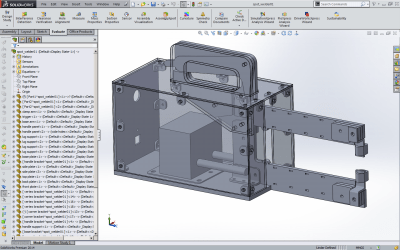
Why? Because he put some serious thought into his design. He even 3D modeled the whole thing in SolidWorks.
Beyond the excellent laser cut enclosure (complete with ratcheting work piece clamping), [Matt’s] also added an Arduino to create a timing circuit. Most times you just squeeze the clamp, press the button, and watch the metal heat up — “I think that’s good…”
But with an actual timing circuit you can calculate how much time you need versus current and electrode size to produce a good quality weld.
Now all he needs is a force gauge!
[Thanks Cibomahto!]

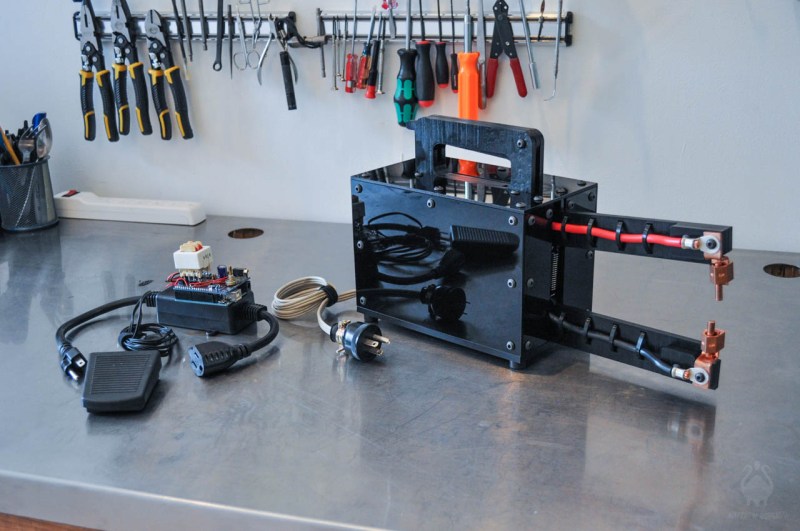






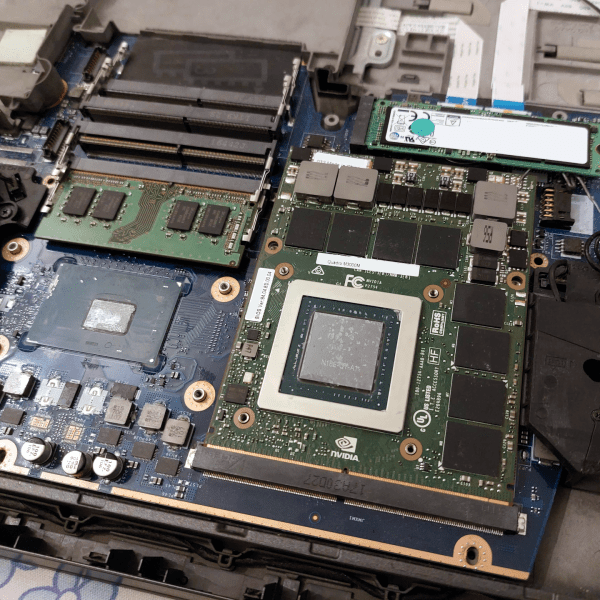

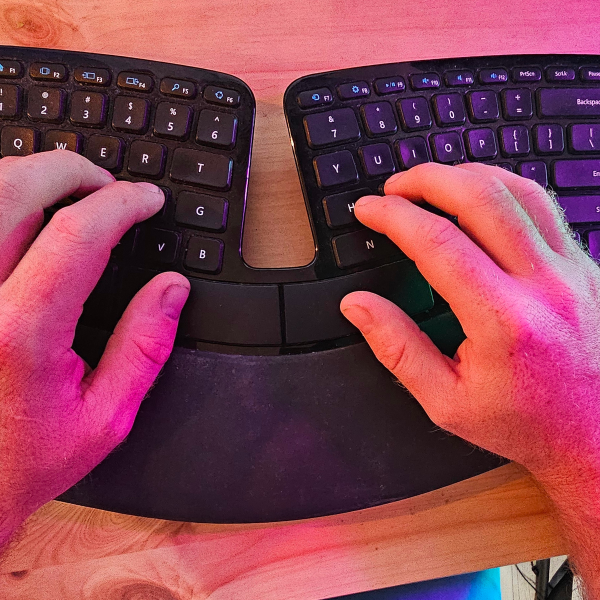
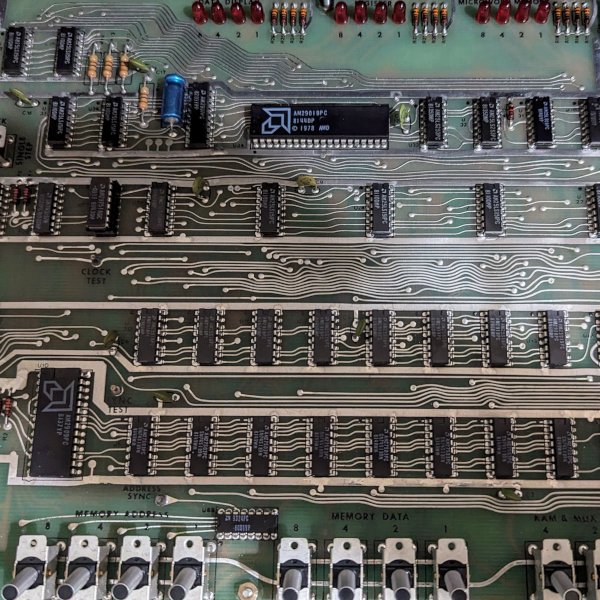




After seeing the film name I thought for a second that this device emits microwaves in order to spot weld.
That’s beautiful. I like the adjustable timing setup. I also like the ease of changing electrodes in this design.
Really, it is not very well designed. The wires are way too small and the electrode holders are a joke. Its pretty much of a refined version of the terrible Kind of Random build.
This guy built a very nice spot welder to build his little turbine engines, it has good tongs and holders:
http://www.5bears.com/welder.htm
The wires are bigger in this one (2 AWG). 2 gauge is bigger than 4 gauge.
It looks like he is only using two gauge on the primary and then switches to something lighter.
Yep, the 2AWG is on the secondary, and then he switches to 4AWG for the tongs.
Those are nice electrode holders.
Your very nice one has smaller wires and even states it can’t be used for very long because it overheats.
His also runs at a higher voltage which allows you to use less current.
It doesn’t work that way with spot welding. You need the current to heat and melt the parts to be joined.
It does for the most part. Thats why stud welders use high voltage, they need to run long leads to the weld head and dragging large cables would get old fast. You can run higher voltage at lower current or vice versa, either way the same energy is at the tongs. Higher voltage also lessens the effect voltage drop and current limiting from the length of the wires. Even on the small hand held Miller spot welders with 5/8″ tongs you loose 1000A per 6″ of tong length at about 1.5v OCV.
FWIW, I used to repair welding equipment including spot welders up to 150KVA.
In this case a higher voltage will help overcome resistive losses in the conductors involved (to some extent). Stud welders work differently. They work more like an arc welder initially, then as the voltage drops across the arc (when the stud is seated), the current shoots up to a limit determined by the voltage drop of the cabling.
@ macona – Have you ever worked on one of those “roll seam welder” setups? I have always wanted to see a home built version of that. =
https://www.youtube.com/watch?v=Ts4uqZvvZCE
Really, that is not well commented. The sentences are too short. It barely register above a youtube comment. Some other guy made a much better comment on a cool project with lightsabres.
I think your comment is pretty childish: this project had obviously a lot of work going into the design. Perhaps there is some room for improvement, I’m sure the builder(/everybody) will appreciate some constructive criticism if you have found a genuine weak spot.
Lastly: the project you linked to has no enclosure, uses expensive ancient logic, no pre-designed drawings and finally: It uses #4 cable, the same stuff you criticised here…
The length of the small gauge wires at the tongs and the small contact area of the screw clamps he is using to hold the electrodes significantly reduces the maximum current that the spot welder can produce. The result can be seen in the video where he welds the two washers together. There should be sparks flying out between the two pieces of metal, this is a sign of enough current going into the work. With the one I posted he is using a higher voltage (assuming the primary has similar amount of turns). This coupled with the large diameter tongs means he has probably double the current and maybe 4 times the delivered power.
The tongs themselves are another issue, there is no way they can put enough pressure on the joint for a proper weld.
There is nothing wrong with the simple timer that he uses, they can be found cheap and are very easy to set.
Nice mechanicals but why leave the electronics such a mess?
At least it wasn’t on a breadboard….
Dan Gelbart’s homemade rig in part 5 of his recently-mentioned 18-part series is excellent. Unfortunately, he provides no details, he just shows you what a spot welder is good for.
https://www.youtube.com/watch?v=82Iil0fFN9Y
Indeed his homemade one is so good that it blows the one in this post out of the water. But then again he is a professional with an amazing shop so his almost doesn’t count as homemade, in fact his is probably better than most professional ones.
His most recent video was showing his homemade FRIGGING ONE-OF-A-KIND MICROMETER HIGH PRECISION AIR BEARING CNC LATHE!
I’ve still got all his videos on my ‘to watch’ list; that was surprisingly informative as I hadn’t quite appreciated how versatile a spot welder could be (nor what the trade-offs were that needed to be considered when using it).
– Again?!?
– Again.
https://www.youtube.com/watch?v=_GLzXVKlzUg
That helped clear things up.
It sounds as incredible as that alien story, but there was another spot welder article just a day ago before this one.
looks good, just be very careful when welding materials coated with zinc, (like the washers shown being welded in the video). the fumes emitted when welding them can leave you brain dead or completely dead if inhaled. Use a wire wheel to remove the zinc based coating and you’re safe. feel free to ask about this on any welding forum. it’s great to see a home made tool and even better when its well planned and executed, Just know the safety precautions needed, in this case being safe with the material, as much as the welder.
google ‘zinc fever’ or ‘metal fume fever’.
Two washers are not going to kill you, the dose of zinc oxide you could get from it is way too low as there is little zinc on them in the first place.
As for your braindead or dead claims: Just a cursory look on wikipedia would have noticed that there are no casualties reported for it. However: “In 2006, there were approximately 700 metal fume exposures reported to United States Poison control center. The American Welding Society estimated that 2500 employees in the steel industry develop metal fume fever in the US each year since the majority of the cases are not reported.” So not only are there no known deaths, most cases are so insignificant they are not reported.
Not sure why there are no “reported” deaths, one of the members of an online blacksmithing forum I frequented died from zinc exposure.
Maybe you should report it.
It is good to see somebody having a go , Good on you Mate . Good work ,
Well, *I* didn’t know you could use a rewrapoed microwave transformer. I need to out more work into locating the anti-hack allen required to open tbem. Cannot find one locally even in great tool shops.
TACT when dissing a design is actually beneficial, as the medium is the message. Do it right and the message actually gets across better. Besides, less egg on your face if you assidentally, err. ;>) Making people defensive stifles creativity AND sharing.
It ain’t perfekt. But, It ain’t too bad at all !!! ;>)))